How to Create a Task List Template in Zenkit
Use the Clone Collection feature to save time and maximize productivity

Here at Zenkit, we sure love a good list. Task list, to-do list, checklist, you name it, we can’t get enough. With our list view combined with the task-list add-on, it makes a great Wunderlist alternative for Wunderlist users looking for a new app come May!
So far, we’ve given you tips on how to create a task list, discussed the benefits of both paper and online solutions, and suggested methods and techniques that could be used alongside your list to give you that extra pep in your productivity. And now, we’ll show you how you can create a task list template.
But first, a quick refresher…
Task List Best Practices
- Think quality, not quantity—remember, a long list doesn’t equal a good list. Keeping tasks to a minimum means you set yourself a realistic and achievable goal.
- Prioritizing tasks maximizes your task list’s productivity value.
- Set clear instructions when describing your task. Avoid being vague, as uncertainty can decrease your chances of actually completing the task. A good tip is to start your task with a verb, e.g. “read chapters 5–10.”
- Include leeway time so that interruptions are accounted for.
Methods to Try for Increased Productivity
- Getting Things Done, or GTD for short is a framework for organizing and tracking tasks. It forces you to add both context and structure to tasks so that the items on your task list are really the things you need to do.
- Time blocking is a technique designed to help us tackle the tasks on our list by scheduling certain periods of time in which to tackle specific tasks. Interruptions and distractions aren’t permitted during these time blocks.
- Eat that frog 🐸 is a method that encourages you to tackle your biggest task first thing. The idea is that once that task is out of the way, it will set the ball rolling for the rest of your tasks for the day.
The Age-Old Debate:Pen & Paper vs Online
- Paper is the most adaptive method, and there’s nothing more satisfying than crossing off a completed task on an actual list.
- Online task lists offer flexibility as they’re available on various platforms, and let’s face it, most of us are more likely to have our phones with us than a piece of paper and a pen.
- Ultimately, the decision is yours. Everyone has a different style of working and in order to optimize your productivity, different tools, methods, and techniques have to be utilized because what works for your friend or colleague may not work for you.

Why We Create Task Lists
When it comes to productivity, be it personal or professional, task lists are inevitable. Whether it’s your weapon of choice for getting organized or if it’s used alongside another method or technique, you’re bound to find yourself creating one.
But why do we do it? Why are we so quick to create task lists even though most of us don’t actually finish them? A LinkedIn study found that out of the 63% of professionals surveyed who use task lists, only 11% of them actually completed all their set tasks!
Psychologist and author, Dr David Cohen, puts our devotion to task lists down to three things: “they reduce anxiety about the chaos of life; they offer structure, and they are proof of what we’ve achieved.”
Another explanation provided is that the simple act of writing down tasks lifts a massive weight off our shoulders, and that, in itself, is reason enough.
The Zeigarnik effect theorizes why we find it so hard to forget about uncompleted tasks. Described by Russian psychiatrist and psychologist, Bluma Wulfovna Zeigarnik in the 1920s, it illustrates our brains’ fixation with tasks that need to be done or tasks that we’ve set out to do but hasn’t completed.
Professors E.J. Masicampo and Roy F. Baumeister of Florida State University furthered this theory in a more recent study and found that unfulfilled goals do persist in the mind. They explored the behaviours of participants who were allowed to construct plans for their unfulfilled goals prior to undertaking an unrelated reading task, as well as participants who weren’t allowed to. The former wasn’t affected by various activation and interference effects, whereas the latter group were.
In other words, what the study found was that although we cannot seem to forget about unfulfilled goals and/or uncompleted tasks, simply planning them can relieve us from the overshadowing burden of them.
So, I suppose we shouldn’t feel too bad about our unfinished task lists…🤷
How to Create a Task List Template in Zenkit
As I mentioned earlier, using a task list is inevitable when it comes to getting your life together. We all have those routine tasks that we have to do over and over again—whether it’s devising a sales pitch at work or doing your weekly errands on Saturday morning—so, why not create a template?
Zenkit’s Clone Collection feature enables you to save a task list and then duplicate it as many times over. Using the example of creating a weekly kitchen cleaning task list, here are the incredibly simple steps:
Step 1: Start a new collection
The very first step of the process is to start a new collection. Simply click on the plus icon under My Collections. Make sure you select the ‘Tasks’ option, then give your task list a name and hit ‘Create’.
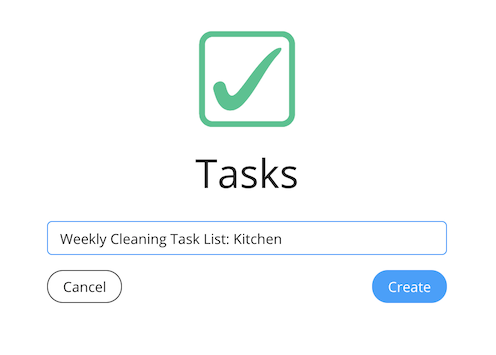
Step 2: List your tasks
As the name would imply, a task list requires tasks, so the next step is to add your routine tasks.
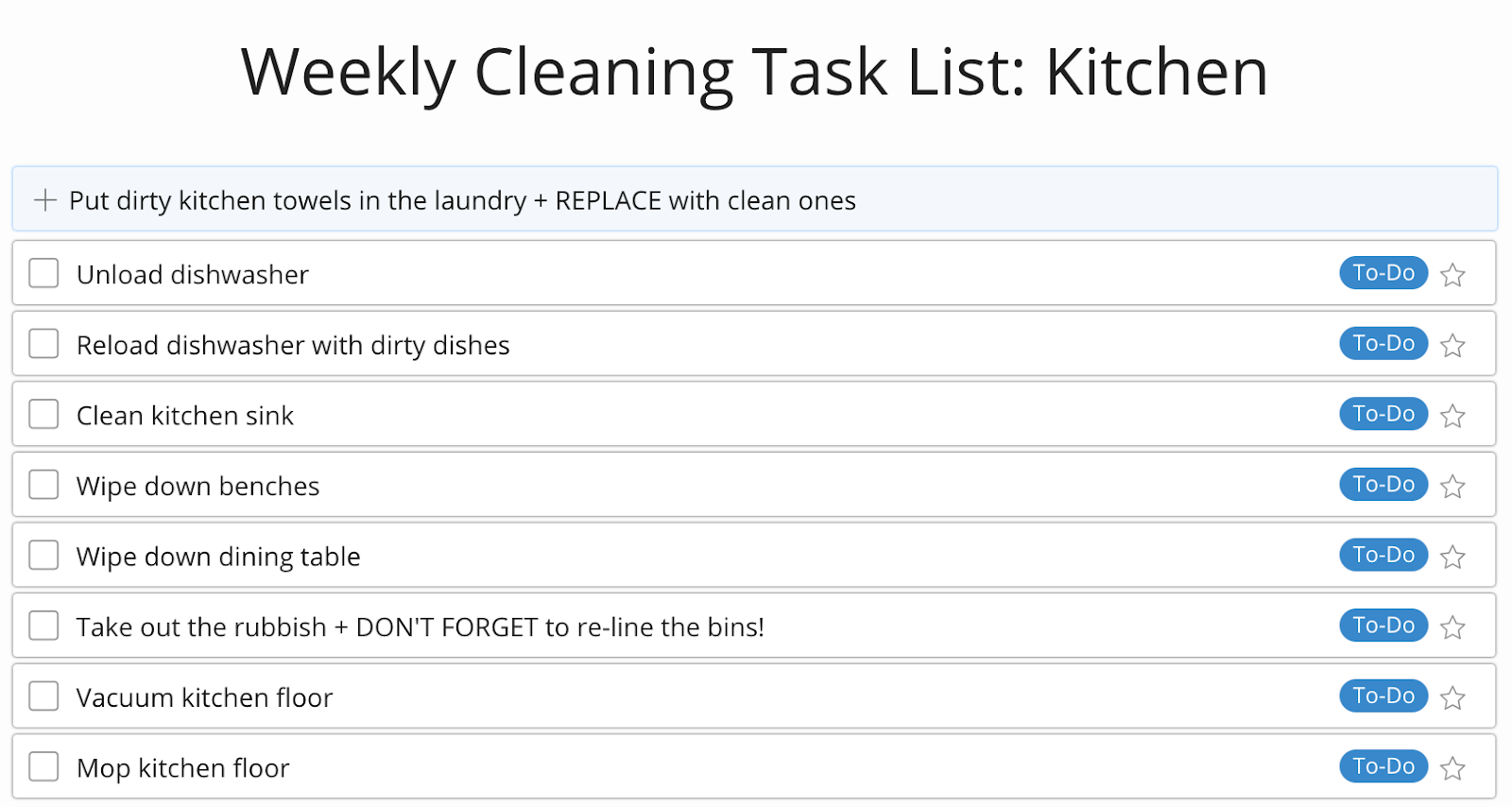
You can rearrange the order of your tasks by simply clicking on a task and then dragging it to the preferred spot.
Step 3: Categorize
The task list feature automatically categorizes the stages into ‘To-Do’ and ‘Done’, however, you can change this to whatever you fancy by adding a new label. To do this, select a task, click on the labels under ‘Stage’, pick ‘Add label’, and write down your new label.

Make sure you apply the new label to all the tasks that require it.
Step 4: Clone Collection
Make a task list template by duplicating your list. Click on the title of your task list, then the “…” symbol on the top, right-hand corner, and select Clone Collection. You then have the option to edit/remove the ‘copy’ bit, add to the task list title, or give the task list a whole different name. Once you’ve done that, hit ‘Clone Collection’.
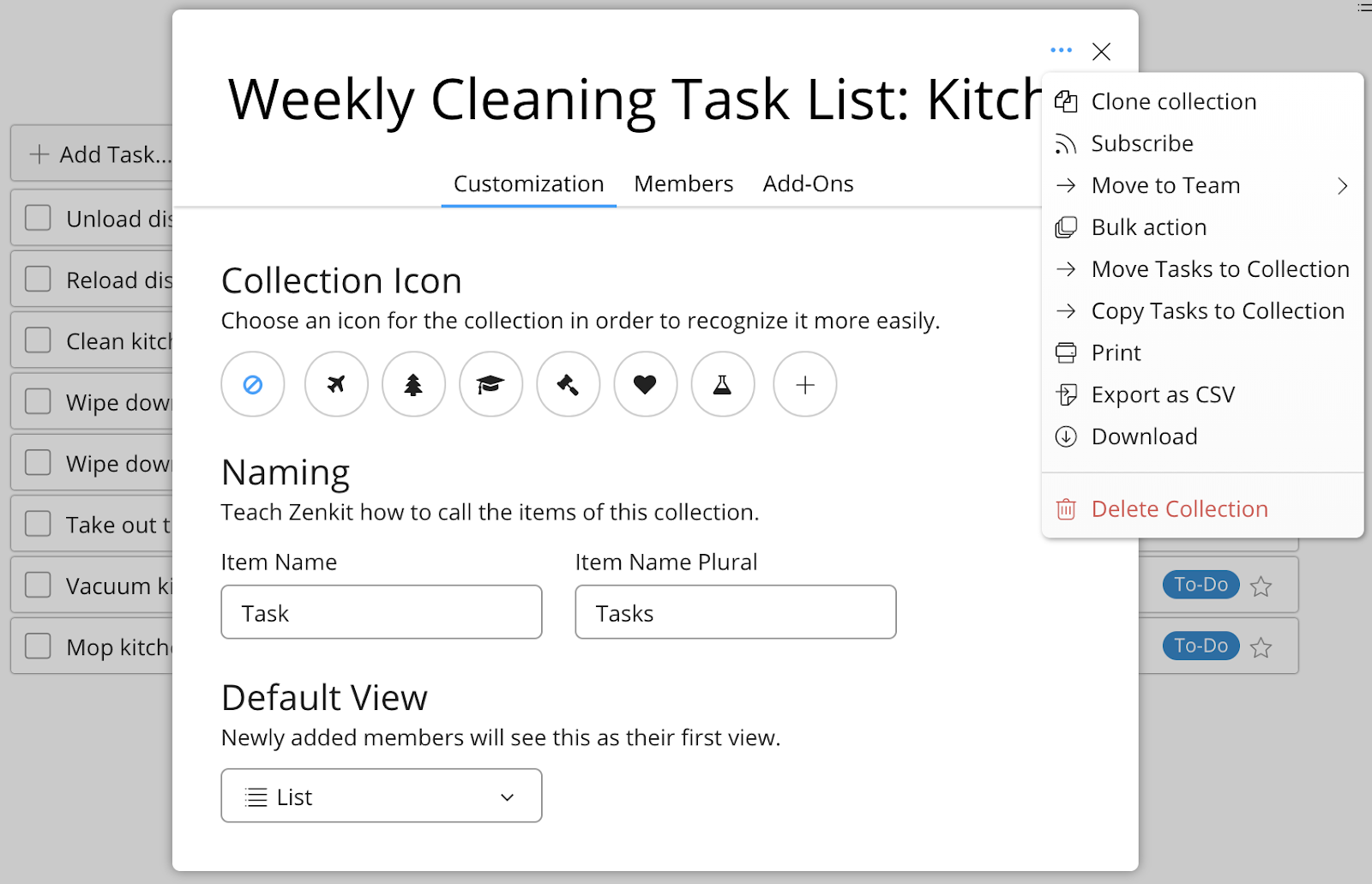
Voila! You’ve just created a task list template!
Employee Task List Template
Task lists are a great way for keeping track of individual tasks and ensuring you’re on top of your daily to-do’s. When it comes to teamwork, however, a better method to use is a Kanban board.
A Kanban board is a visual management tool and scheduling system that works on using visual cues to visualize a work process and identify any bottlenecks. The way it works is that there are columns on the board that represent various stages of a work process. Cards are then used to represent tasks that get moved along the board depending on which stage of the process they’re at. A typical board would consist of three columns labelled “To-do”, “Doing”, and “Done”, but you can have as many columns as your team sees fit.
What makes a Kanban board more ideal than a regular task list is it encourages collaboration and shared responsibility. Team members can visualize, manage, and maximize their tasks and workflow. They have to work together effectively and efficiently to make sure tasks are moved along the board accordingly and into the “Done” column. Dragging a task into the “Done” column of a Kanban board is the equivalent to crossing an item off a task list. The feeling can be so satisfying!
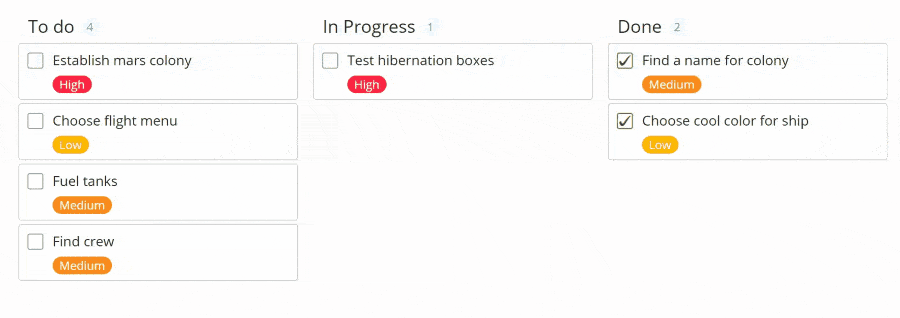
The following templates are examples of how a Kanban board can be used as a daily task list template for work.
1. Project Planner
To manage a project successfully, you need to have a clear overview of the tasks involved. Having a project planning template can help with exactly that. Your team will be able to see who’s responsible for each task and keep track of the progress of tasks.
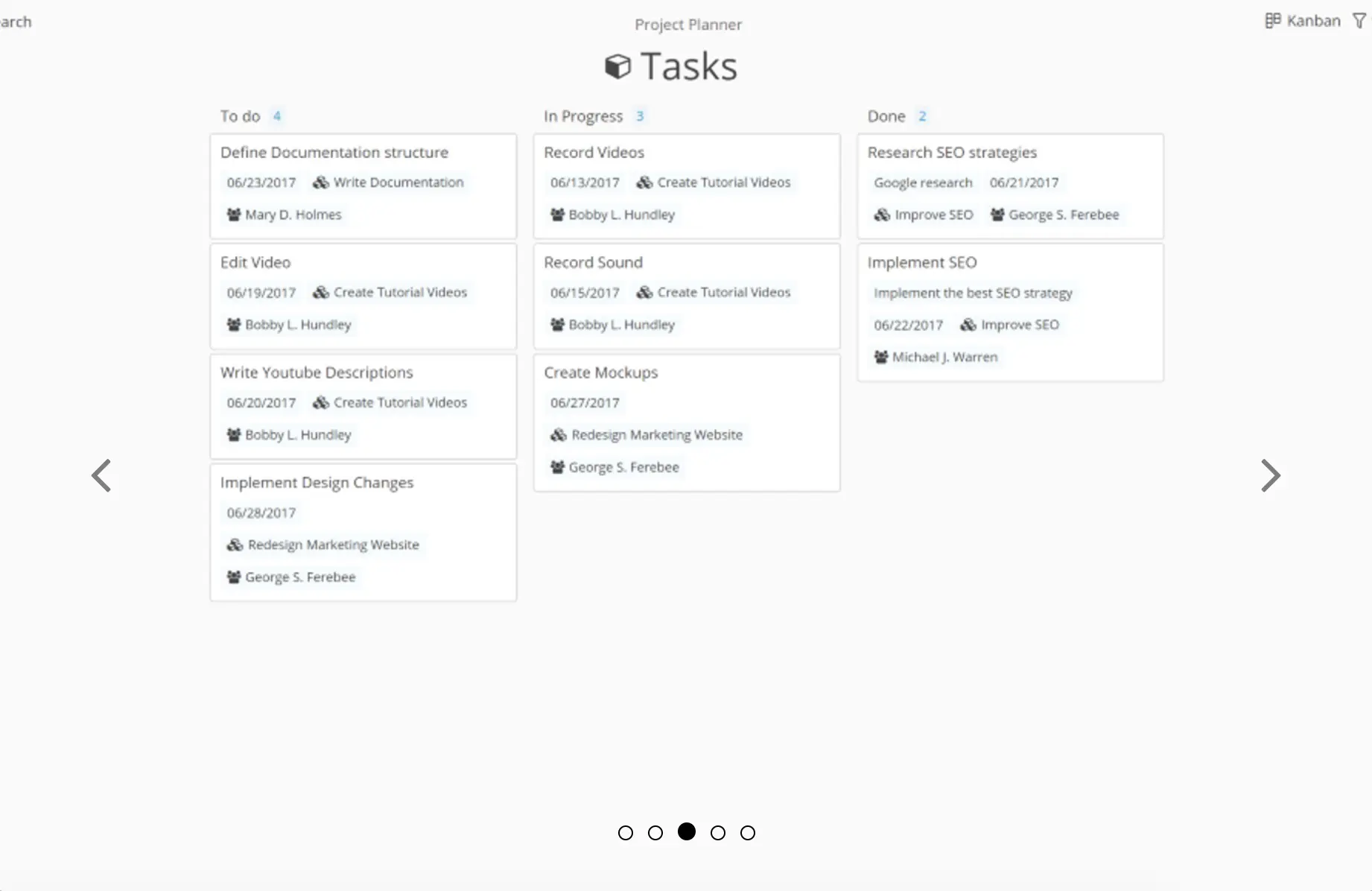
2. Guide for New Employees
Creating a template for new staff onboarding can help the newbies adjust to your company easier.
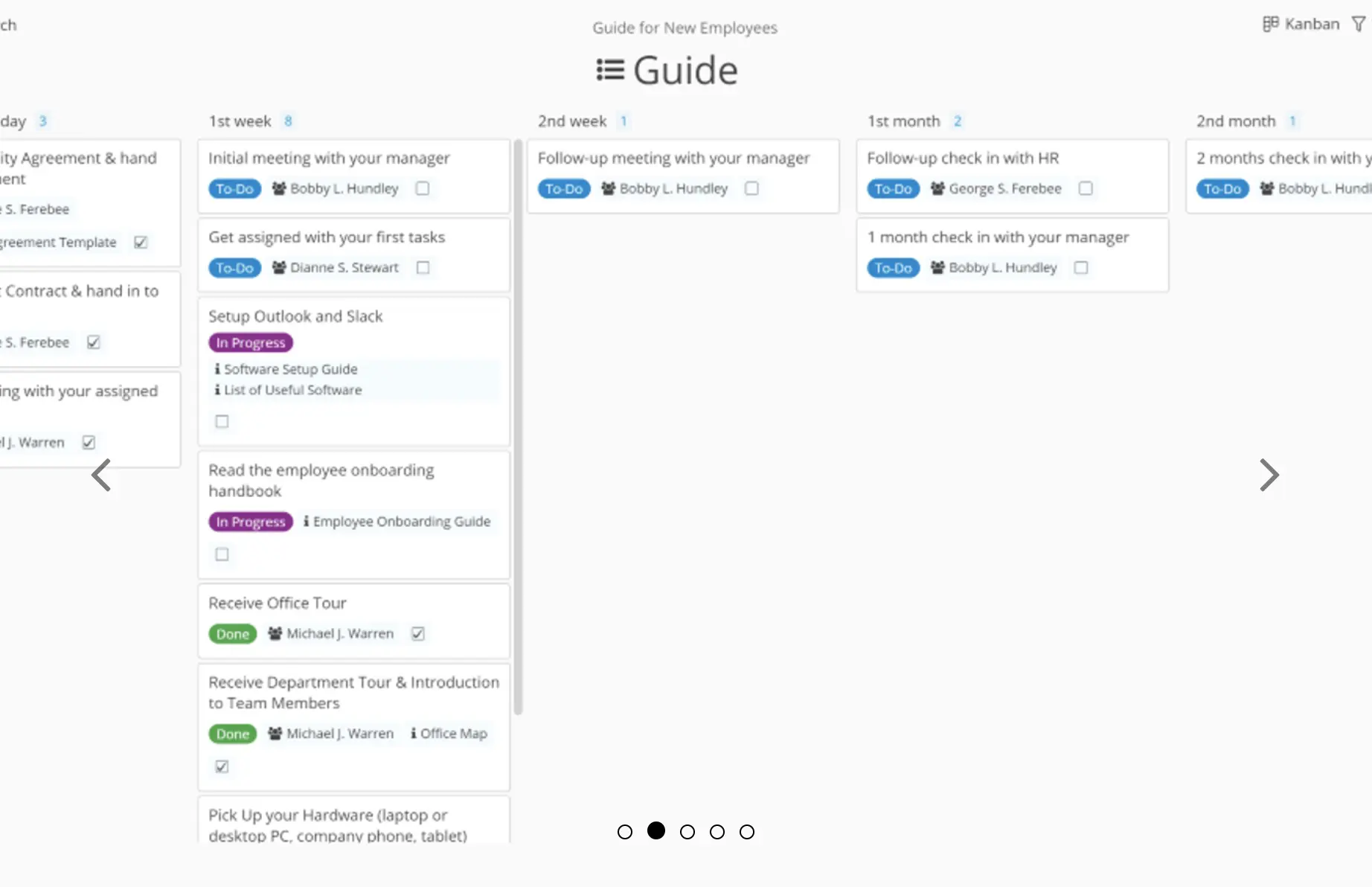
3. Content Creation Planner
Having a content creation planner template, whether it’s for a blog, website, or even a print magazine, will ensure all your ideas are captured, assessed, and transformed into a quality piece of content.
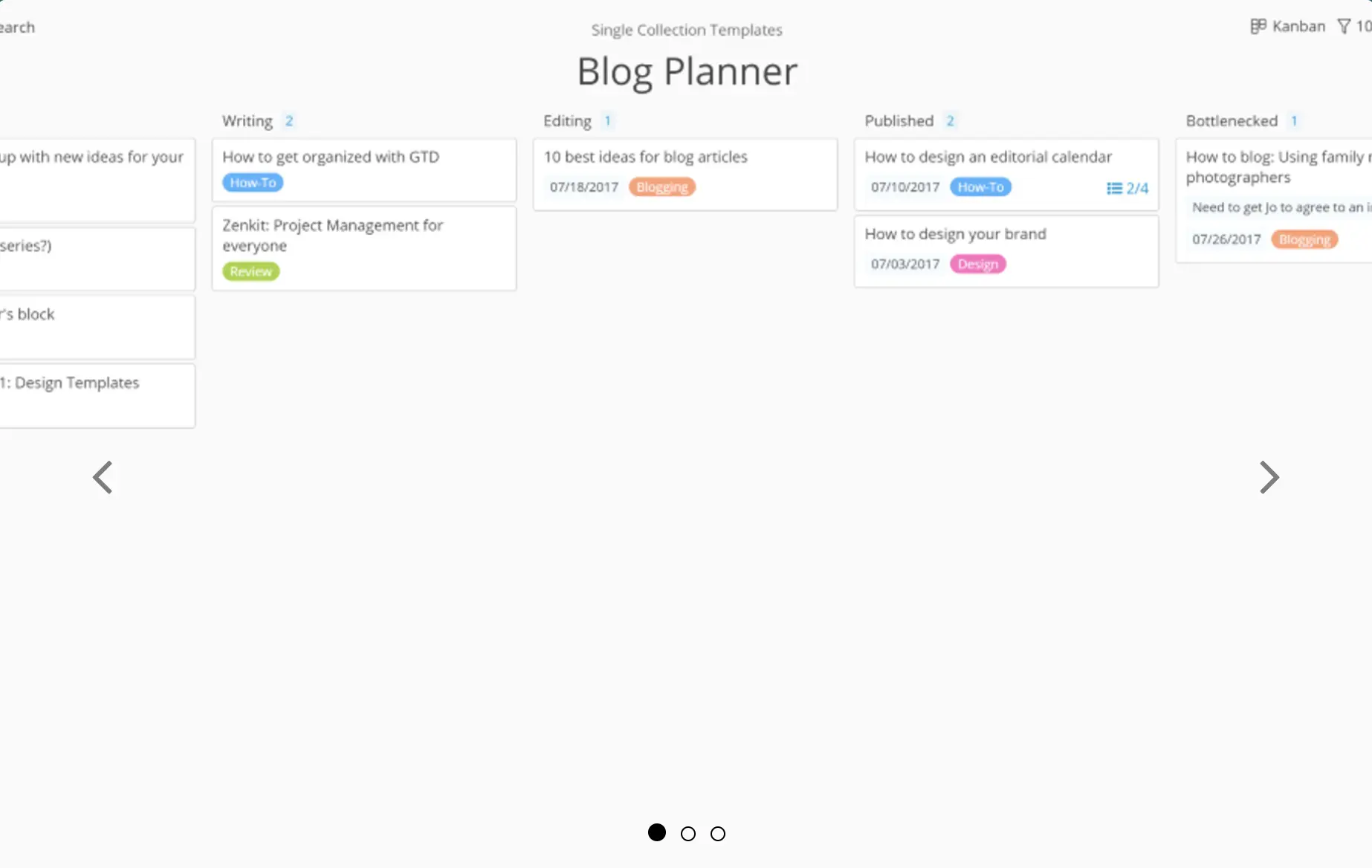
Just like the weekly cleaning task list, you can clone any collection you create and turn them into templates. The steps are the same, simply click on the title of your collection template and then select Clone Collection. Give the template whatever title you want and once that’s done, hit the ‘Clone Collection’ button!
Final Thoughts
Love them or loathe them, task lists aren’t going anywhere anytime soon. An unavoidable aspect of work and home life, they can be the ideal tool for upping your organizational skills and improving your overall productivity.
The aim of the clone collection feature is to save you the task of having to repeatedly write out your recurring to-dos prior to actually tackling your task list. And if there’s something out there that frees you from doing any additional tasks, why not embrace it?
Cheers,
Dinnie and the Zenkit Team
FREE 20 MIN. CONSULTATION WITH A PROJECT MANAGEMENT EXPERT
Wanna see how to simplify your workflow with Zenkit in less than a day?
Book a Live Demo
Same here! Hours and hours of work! Deal breaker, leaving Zenkit even though it has my favourite workflows!
I even sent emails for help and heard nothing back.
Hey Raphael, I’m sorry you were unable to find any help here. Did you send a message to service@zenkit.com? Our team had a look and were unable to find any emails sent from the address you’ve provided here. We do our best to respond to all emails within a day or two, and chats within a few minutes.
IO am very frustrated. I set this up in order to pass on the collection to clients with everything they have to do and the information sources related. Now that I have put the work in, I have discovered that NONE of the links work on the cloned collection. Any solution? I need one fast! Thank you in advance for the support.
Hi Raphael,
I’m sorry to hear that! What do you mean by ‘none of the links work’ exactly? Would you be able to send more info (e.g. screenshots if they’d help) and maybe the URL of the original & cloned collections to service@zenkit.com so our team can investigate this properly?
Cheers,
Siobhan
This did not help me at all. I am so frustrated right now I’ve wasted a lot of time trying to figure out how to make a second checklist. It should not be this hard. I’m switching to something else.
Hi there,
Apologies for this, we had a design change recently that’s yet to be reflected in this article. This will be rectified.
To make a second checklist, simply click on the title of your collection, a menu should appear and there you should find the ‘Clone collection’ tab. If you’d like further assistance, don’t hesitate to contact our friendly customer service team via the in-app chat or by emailing service@zenkit.com.